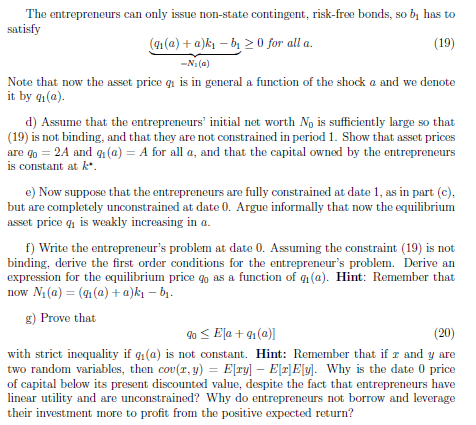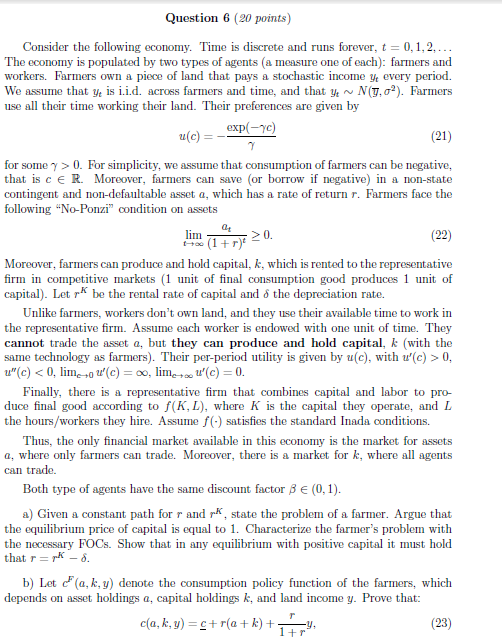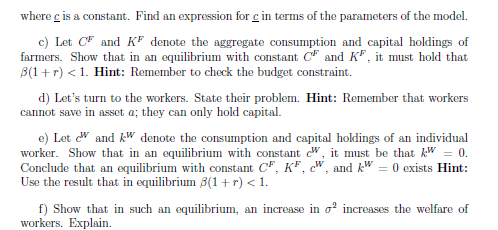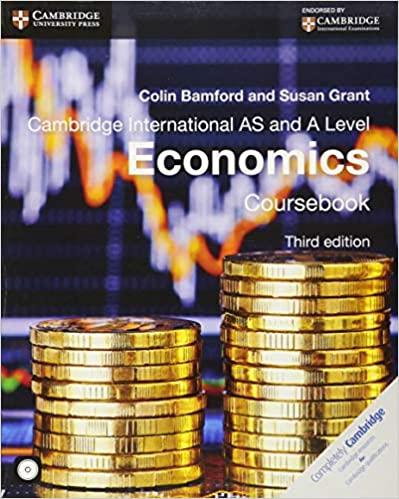


Step by step....
The entrepreneurs can only issue non-state continnt, risk-free bonds, so {:1 has to satisfy {q1|[a}+ a}.i:1 h1 E [l for all I1 [19] u...r nl Note thatnowtheassetpricem isingenereiahinctionoftheshcdraandwedennte iT-hln'Ihil- d] Assume that the entrepreneurs' initial net worth ND is sufficiently large so that {19} is not binding, and that they are not constrained in period 1. Show that asset prices are El'e : 2A and thin} : A {or all 111 and that the capital owned by the entrepreneurs is constant at if\". e} Now suppose that the entrepreneurs are fully constrained at date 1, as in part {c}, but are completely unconstrained at date I]. Argue informally that now the equilibrium asset price qi is weakly increasing in a. f] Wiite the entrepreneur's problem at date I]. Aasruning the constraint [19} is not binding, derive the rst order conditions [or the entrepreneur's problem. Derive an expreesion [or the equilibrium price le as a function of epic]. Hint: Remember that now N; {a} = {q1[a}+ ejki {31. g} Prove that s: E Eh + sdll [20] with strict inequality if qo] is not constant. Hint: Remember that if :r and y are two random variables then m[:,y} = E[zy] E|e|E|y]_ Why is the date [II price of capital below its present discounted value, despite the [act that entrepreneurs have linear utility and are unconstrained? 1|Why do entrepreneurs net borrow and leverage their investment more to prot lIOID the positive expected return? Question E [24'] points} lEonsider the following economy. Time is discrete and runs forever, t = ,1,2,... The emnomy is populated by two types of agents [a measure one of each}: farmers and workers. Earmess own a piece of land that pays a stochastic income 1;. every period. We assume that y: is i_i_d_ across Earmers and time, and that y, m NEE-ca}. Farmers use all their time working their land. Their preferences are given by m} = J'EPlT'Tcl [21) Iior some 1' :n- D. For simplicity, we assume that consumption of farmers can be negative, that is c E R. Moreover, farmers can save {or borrow if negative} in a non-state contingent and non-defaultahle asset c, which has a rate of return 1'. Farmers [ace the thllowing \"No-Fonsi\" condition on assets } a [22) Moreover, farmers can produce and hold capital, k, which is rented to the representative rm in competitive markets [1 unit of nal consumption good produces 1 unit of capital}. Let 1"\" be the rental rate of capital and .5 the depreciation rate. Unlike Earmers, workers don't own land, and they use their available time to work in the representative firm. Assume each worker is endowed with one unit of time. They cannot trade the asset a, but they can produce and hold capital, it [with the same tedinology as farmers]. Their per-period utility is given by u[c], with tr'l[c}| :3- D, tn"{c] a: ll, limu u'{c] = cc, limhm u't'c} = D. Finally1 there is a representative rm that combines capital and labor to pro duce nal good according to liL}, where K is the capital they operate, and L the hoursfworkers they hire. Assume -JI satises the standard Inada conditions. Thus, the only nancial market available in this economy is the market [or assets c, where only farmers can trade. l'vlorvecver1 there is a market for k. where all agents can trade. Both type of agents have the same discount factor ,3 E {11,1}. a} Given a constant path [or r and r\












